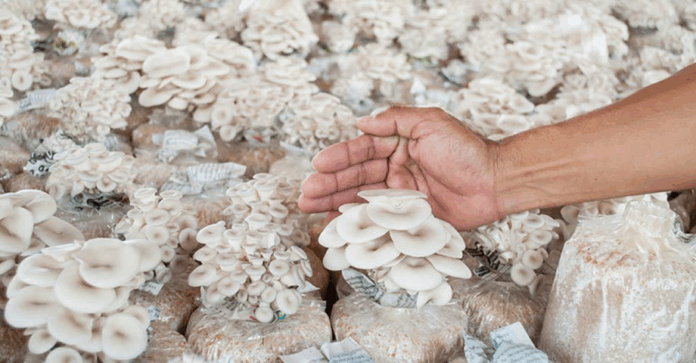Mushroom cultivation in humid climates offers unique opportunities and challenges. The consistent moisture and warmth can be advantageous for mushroom growth but also increase the risk of contamination. This guide provides comprehensive insights into spawn production, effective marketing strategies for health food stores, and methods to prevent mold contamination, ensuring a successful and sustainable mushroom farming venture.
Spawn Production in Humid Climates
Understanding Spawn Production
Spawn is the vegetative growth of the mushroom mycelium, which is used to inoculate the substrate. In humid climates, maintaining the quality of spawn is crucial due to the increased risk of contamination.
Key Considerations:
- Substrate Selection: Common substrates include sorghum grains and sawdust. These materials are readily available and support robust mycelial growth.
- Sterilization: Proper sterilization of substrates is essential to eliminate competing microorganisms. This can be achieved through methods like steam sterilization or chemical treatments.
- Environmental Conditions: Maintaining optimal temperature (20–35°C) and humidity levels is vital for spawn viability.
Challenges and Solutions:
- High Humidity: While beneficial for mycelial growth, excessive humidity can promote mold growth. Implementing proper ventilation and using dehumidifiers can help maintain balanced humidity levels.
- Contamination: Regular monitoring and maintaining sterile conditions during spawn production can minimize contamination risks.
Marketing to Health Food Stores
Understanding the Market
Health food stores are increasingly interested in offering fresh, locally-sourced mushrooms due to their nutritional benefits. Building relationships with these retailers can provide a steady market for your produce.
Strategies for Success:
- Product Quality: Ensure your mushrooms are fresh, clean, and free from defects. Consistent quality builds trust with retailers and consumers.
- Packaging: Use breathable packaging materials to maintain freshness and prevent moisture buildup.
- Education: Provide information on the health benefits of mushrooms and usage suggestions to both retailers and consumers.
- Sampling: Offering samples can introduce your product to potential buyers and encourage purchases.
Building Relationships:
- Communication: Maintain open lines of communication with store managers to understand their needs and preferences.
- Reliability: Consistently meet delivery schedules and order quantities to establish a reputation as a dependable supplier.
Preventing Mold Contamination
Understanding Contamination Risks
Mold contamination is a significant concern in mushroom cultivation, especially in humid environments. Common contaminants include green mold (Trichoderma spp.), black mold, and bacterial blotch.
Prevention Strategies:
- Sanitation: Regularly clean and disinfect all equipment, surfaces, and growing areas to minimize contamination sources.
- Environmental Control: Maintain optimal temperature and humidity levels. Use ventilation systems to prevent stagnant air and moisture buildup.
- Monitoring: Regularly inspect crops for signs of contamination, such as discoloration or unusual odors. Early detection allows for prompt action to prevent spread.
- Quality Spawn: Use high-quality, uncontaminated spawn to reduce the risk of introducing pathogens into your cultivation system.
Response to Contamination:
- Isolation: Immediately isolate and remove contaminated materials to prevent the spread to healthy crops.
- Review Practices: Analyze and adjust cultivation practices to address the source of contamination and prevent recurrence.
Integrated Strategies for Success in Humid Climates
Harmonizing Spawn Production and Environmental Control
In humid climates, maintaining optimal conditions for spawn production is crucial. High humidity levels can promote mycelial growth but also increase the risk of contamination.
- Sterile Techniques: Implement rigorous sterilization protocols for substrates and equipment to minimize contamination risks.
- Environmental Monitoring: Use hygrometers and thermometers to monitor humidity and temperature levels, ensuring they remain within optimal ranges.
- Ventilation: Ensure adequate airflow to prevent the buildup of excess moisture, which can lead to mold growth.
Aligning Production with Market Demand
Understanding the preferences of health food stores and consumers can guide your cultivation choices.
- Variety Selection: Focus on mushroom varieties that are popular among health-conscious consumers, such as oyster, shiitake, and lion’s mane.
- Quality Assurance: Maintain consistent quality and freshness to build trust with buyers.
- Feedback Integration: Solicit feedback from store owners and customers to refine your offerings and address any concerns promptly.
Implementing a Proactive Contamination Management Plan
Preventing mold contamination requires a proactive and systematic approach.
- Regular Inspections: Conduct routine checks for signs of contamination, such as discoloration or unusual odors.
- Immediate Response: If contamination is detected, isolate and remove affected materials promptly to prevent spread.
- Continuous Improvement: Regularly review and update your cultivation practices to incorporate new insights and technologies that enhance contamination control.
Embracing Continuous Learning and Adaptation
The dynamic nature of mushroom cultivation, especially in humid climates, necessitates ongoing learning and adaptability.
- Stay Informed: Keep abreast of the latest research and advancements in mushroom cultivation techniques.
- Community Engagement: Participate in local and online communities of mushroom growers to share experiences and learn from others.
- Experimentation: Be open to experimenting with new methods and technologies that could enhance your cultivation process.
By integrating these strategies, you can navigate the complexities of mushroom cultivation in humid climates, ensuring a successful and sustainable farming venture.
Mushroom cultivation in humid climates presents both opportunities and challenges. By focusing on high-quality spawn production, building strong relationships with health food stores, and implementing rigorous contamination prevention strategies, you can establish a thriving mushroom farming business. Continuous learning and adaptation are key to overcoming obstacles and achieving long-term success in this rewarding field.


